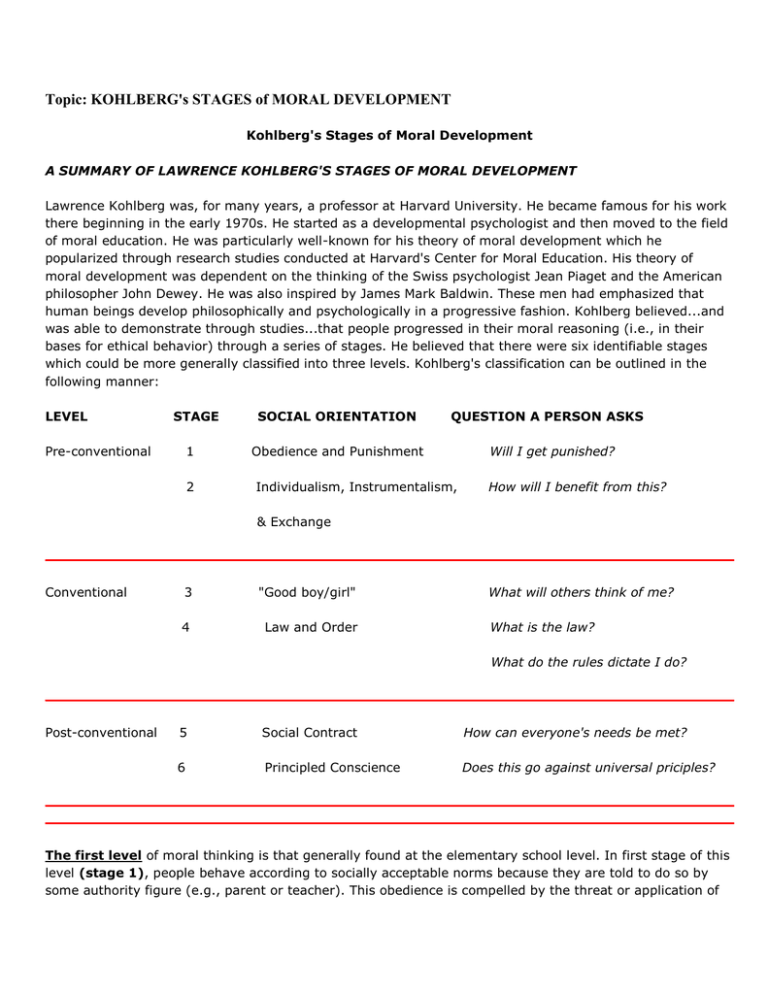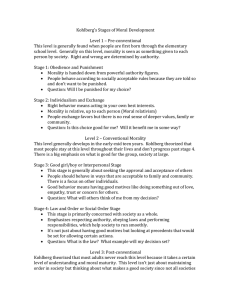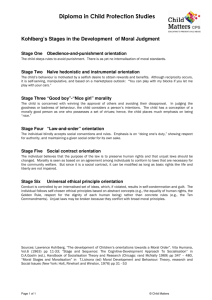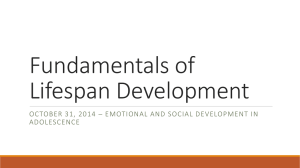Topic: KOHLBERG's STAGES of MORAL DEVELOPMENT
advertisement

Topic: KOHLBERG's STAGES of MORAL DEVELOPMENT Kohlberg's Stages of Moral Development A SUMMARY OF LAWRENCE KOHLBERG'S STAGES OF MORAL DEVELOPMENT Lawrence Kohlberg was, for many years, a professor at Harvard University. He became famous for his work there beginning in the early 1970s. He started as a developmental psychologist and then moved to the field of moral education. He was particularly well-known for his theory of moral development which he popularized through research studies conducted at Harvard's Center for Moral Education. His theory of moral development was dependent on the thinking of the Swiss psychologist Jean Piaget and the American philosopher John Dewey. He was also inspired by James Mark Baldwin. These men had emphasized that human beings develop philosophically and psychologically in a progressive fashion. Kohlberg believed...and was able to demonstrate through studies...that people progressed in their moral reasoning (i.e., in their bases for ethical behavior) through a series of stages. He believed that there were six identifiable stages which could be more generally classified into three levels. Kohlberg's classification can be outlined in the following manner: LEVEL STAGE Pre-conventional 1 2 SOCIAL ORIENTATION QUESTION A PERSON ASKS Obedience and Punishment Individualism, Instrumentalism, Will I get punished? How will I benefit from this? & Exchange Conventional 3 "Good boy/girl" 4 Law and Order What will others think of me? What is the law? What do the rules dictate I do? Post-conventional 5 Social Contract How can everyone's needs be met? 6 Principled Conscience Does this go against universal priciples? The first level of moral thinking is that generally found at the elementary school level. In first stage of this level (stage 1), people behave according to socially acceptable norms because they are told to do so by some authority figure (e.g., parent or teacher). This obedience is compelled by the threat or application of punishment. The second stage of this level (stage 2), is characterized by a view that right behavior means acting in one's own best interests. The second level of moral thinking is that generally found in society, hence the name "conventional." The first stage of this level (stage 3) is characterized by an attitude which seeks to do what will gain the approval of others. The second stage (stage 4)is one oriented to abiding by the law and responding to the obligations of duty. The third level of moral thinking is one that Kohlberg felt is not reached by the majority of adults. Its first stage (stage 5) is an understanding of social mutuality and a genuine interest in the welfare of others. The last stage (stage 6) is based on respect for universal principle and the demands of individual conscience. While Kohlberg always believed in the existence of Stage 6 and had some nominees for it, he could never get enough subjects to define it, much less observe their longitudinal movement to it. Kohlberg believed that individuals could only progress through these stages one stage at a time. That is, they could not "jump" stages. They could not, for example, move from an orientation of selfishness to the law and order stage without passing through the good boy/girl stage. They could only come to a comprehension of a moral rationale one stage above their own. Thus, according to Kohlberg, it was important to present them with moral dilemmas for discussion which would help them to see the reasonableness of a "higher stage" morality and encourage their development in that direction. The last comment refers to Kohlberg's moral discussion approach. He saw this as one of the ways in which moral development can be promoted through formal education. Note that Kohlberg believed, as did Piaget, that most moral development occurs through social interaction. The discussion approach is based on the insight that individuals develop as a result of cognitive conflicts at their current stage.





